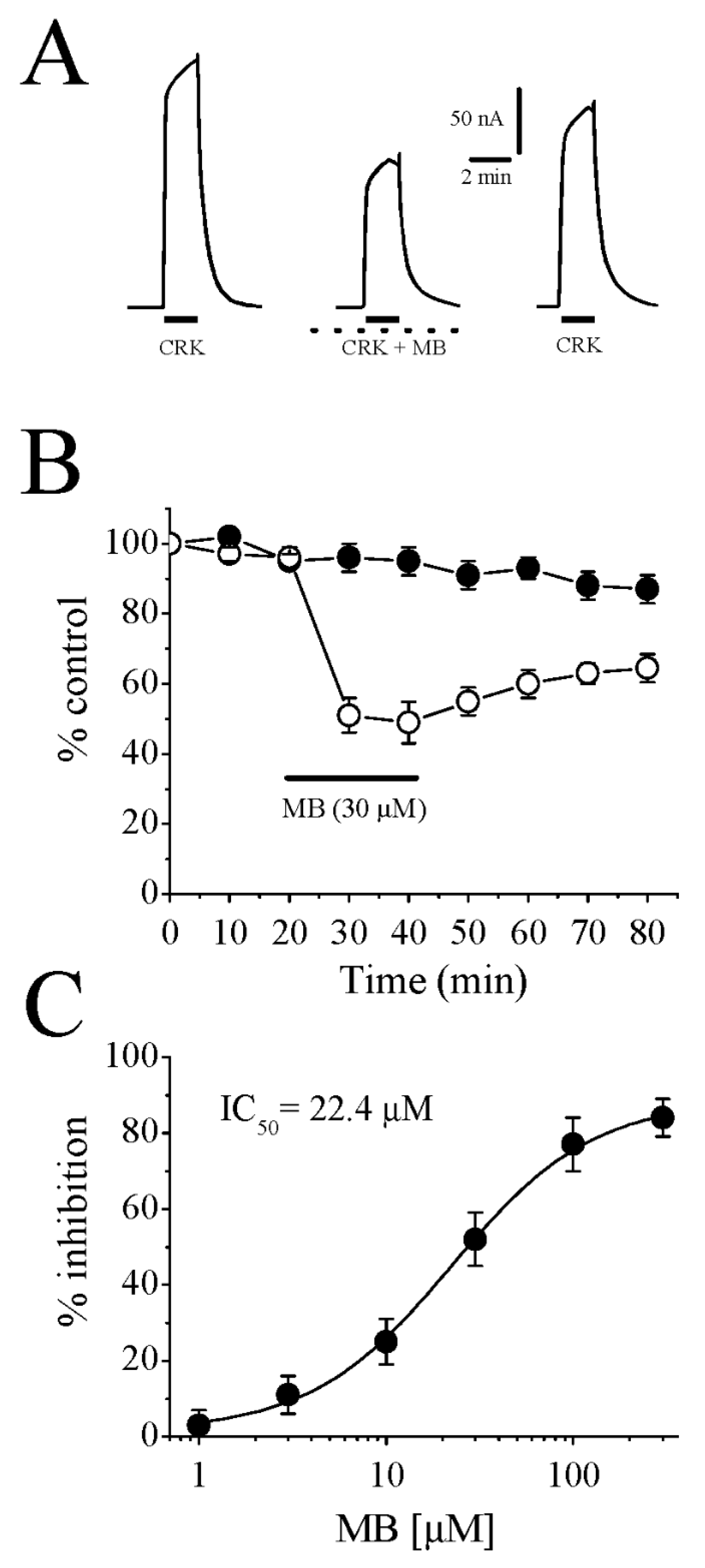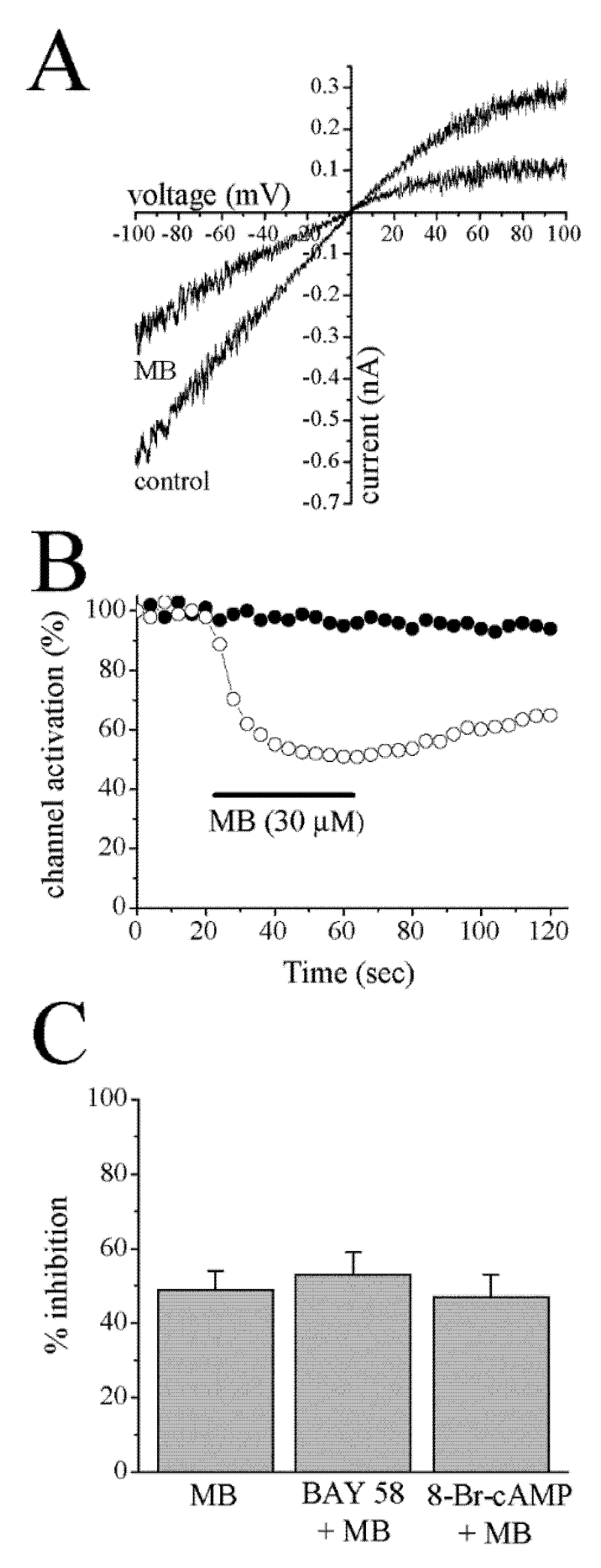Methylene Blue Inhibits Cromakalim-Activated K+ Currents in Follicle-Enclosed Oocytes
Abstract
1. Introduction
2. Materials and Methods
3. Results
4. Discussion
Author Contributions
Funding
Institutional Review Board Statement
Informed Consent Statement
Data Availability Statement
Acknowledgments
Conflicts of Interest
References
- Wainwright, M.; Crossley, K. Methylene Blue—A Therapeutic Dye for All Seasons? J. Chemother. 2002, 14, 431–443. [Google Scholar] [CrossRef] [PubMed]
- Oz, M.; Lorke, D.E.; Petroianu, G.A. Methylene blue and Alzheimer’s disease. Biochem. Pharmacol. 2009, 78, 927–932. [Google Scholar] [CrossRef] [PubMed]
- Oz, M.; Lorke, D.E.; Hasan, M.; Petroianu, G.A. Cellular and molecular actions of Methylene Blue in the nervous system. Med. Res. Rev. 2011, 31, 93–117. [Google Scholar] [CrossRef]
- Oktay, S.; Onat, F.; Karahan, F.; Alican, I.; Ozkutlu, U.; Yegen, B. Effect of Methylene Blue on Blood Pressure in Rats. Pharmacology 1993, 46, 206–210. [Google Scholar] [CrossRef]
- Cheng, X.; Pang, C.C.Y. Pressor and vasoconstrictor effects of methylene blue in endotoxaemic rats. Naunyn-Schmiedeberg’s Arch. Pharmacol. 1998, 357, 648–653. [Google Scholar] [CrossRef]
- Levin, R.L.; Degrange, M.A.; Bruno, G.F.; Del Mazo, C.D.; Taborda, D.J.; Griotti, J.J.; Boullon, F.J. Methylene blue reduces mortality and morbidity in vasoplegic patients after cardiac surgery. Ann. Thorac. Surg. 2004, 77, 496–499. [Google Scholar] [CrossRef]
- Özal, E.; Kuralay, E.; Yildirim, V.; Kilic, S.; Bolcal, C.; Kücükarslan, N.; Günay, C.; Demirkilic, U.; Tatar, H. Preoperative Methylene Blue Administration in Patients at High Risk for Vasoplegic Syndrome During Cardiac Surgery. Ann. Thorac. Surg. 2005, 79, 1615–1619. [Google Scholar] [CrossRef]
- Lavigne, D. Vasopressin and Methylene Blue: Alternate Therapies in Vasodilatory Shock. Semin. Cardiothorac. Vasc. Anesthesia 2010, 14, 186–189. [Google Scholar] [CrossRef] [PubMed]
- Starkus, J.; Heggeness, S.; Rayner, M. Kinetic analysis of sodium channel block by internal methylene blue in pronased crayfish giant axons. Biophys. J. 1984, 46, 205–218. [Google Scholar] [CrossRef] [PubMed]
- Thuneberg, L. Methylene blue as a pharmacological probe of intestinal pacemaker activity. Am. J. Physiol. Liver Physiol. 1990, 258, G992–G994. [Google Scholar] [CrossRef]
- Stockand, J.D.; Sansom, S.C. Activation by methylene blue of large Ca2+-activated K+ channels. Biochim. Biophys. Acta (BBA) Biomembr. 1996, 1285, 123–126. [Google Scholar] [CrossRef]
- Abi-Gerges, N.; Eschenhagen, T.; Hove-Madsen, L.; Fischmeister, R.; Mery, P.-F. Methylene Blue Is a Muscarinic Antagonist in Cardiac Myocytes. Mol. Pharmacol. 1997, 52, 482–490. [Google Scholar] [CrossRef] [PubMed]
- Al Mansouri, A.S.; Lorke, D.E.; Nurulain, S.M.; Ashoor, A.; Keun-Hang, S.Y.; Petroianu, G.; Isaev, D.; Oz, M. Methylene blue inhibits the function of α7-nicotinic acetylcholine receptors. CNS Neurol. Disord. Drug Targets 2012, 11, 791–800. [Google Scholar] [CrossRef] [PubMed]
- Oz, M.; Isaev, D.; E Lorke, D.; Hasan, M.; Petroianu, G.; Shippenberg, T.S. Methylene blue inhibits function of the 5-HT transporter. Br. J. Pharmacol. 2012, 166, 168–176. [Google Scholar] [CrossRef] [PubMed]
- Küçükkılınç, T.; Özer, I. Multi-site inhibition of human plasma cholinesterase by cationic phenoxazine and phenothiazine dyes. Arch. Biochem. Biophys. 2007, 461, 294–298. [Google Scholar] [CrossRef]
- Ramsay, R.; Dunford, C.; Gillman, K. Methylene blue and serotonin toxicity: Inhibition of monoamine oxidase A (MAO A) confirms a theoretical prediction. Br. J. Pharmacol. 2007, 152, 946–951. [Google Scholar] [CrossRef]
- Quast, U.; Guillon, J.-M.; Cavero, I. Cellular pharmacology of potassium channel openers in vascular smooth muscle. Cardiovasc. Res. 1994, 28, 805–810. [Google Scholar] [CrossRef]
- Mannhold, R. KATP channel openers: Structure-activity relationships and therapeutic potential. Med. Res. Rev. 2004, 24, 213–266. [Google Scholar] [CrossRef]
- Edwards, G.; Weston, A.H. The Pharmacology of ATP-Sensitive Potassium Channels. Annu. Rev. Pharmacol. Toxicol. 1993, 33, 597–637. [Google Scholar] [CrossRef]
- Gribble, F.; Reimann, F. Pharmacological modulation of KATP channels. Biochem. Soc. Trans. 2002, 30, 333–339. [Google Scholar] [CrossRef]
- Rubaiy, H.N. The therapeutic agents that target ATP-sensitive potassium channels. Acta Pharm. 2016, 66, 23–34. [Google Scholar] [CrossRef] [PubMed]
- Yokoshiki, H.; Sunagawa, M.; Seki, T.; Sperelakis, N. ATP-sensitive K+channels in pancreatic, cardiac, and vascular smooth muscle cells. Am. J. Physiol. 1998, 274, C25–C37. [Google Scholar] [CrossRef] [PubMed]
- Nichols, C.G. Adenosine Triphosphate-Sensitive Potassium Currents in Heart Disease and Cardioprotection. Card. Electrophysiol. Clin. 2016, 8, 323–335. [Google Scholar] [CrossRef]
- Tinker, A.; Aziz, Q.; Li, Y.; Specterman, M. ATP-Sensitive Potassium Channels and Their Physiological and Pathophysiological Roles. Compr. Physiol. 2018, 8, 1463–1511. [Google Scholar] [CrossRef] [PubMed]
- Rosenblum, W.I. ATP-Sensitive Potassium Channels in the Cerebral Circulation. Stroke 2003, 34, 1547–1552. [Google Scholar] [CrossRef]
- Honoré, E.; Lazdunski, M. Hormone-regulated K+ channels in follicle-enclosed oocytes are activated by vasorelaxing K+ channel openers and blocked by antidiabetic sulfonylureas. Proc. Natl. Acad. Sci. USA 1991, 88, 5438–5442. [Google Scholar] [CrossRef]
- Sakuta, H.; Sekiguchi, M.; Okamoto, K.; Sakai, Y. Inactivation of glibenclamide-sensitive K+ channels in Xenopus oocytes by various calmodulin antagonists. Eur. J. Pharmacol. Mol. Pharmacol. 1992, 226, 199–207. [Google Scholar] [CrossRef]
- Arellano, R.O.; Woodward, R.M.; Miledi, R. ION Channels and Membrane Receptors in Follicle-Enclosed Xenopus Oocytes. Ion Channels 1996, 4, 203–259. [Google Scholar] [CrossRef]
- Zhang, L.; Oz, M.; Weight, F.F. Potentiation of 5-HT3 receptor-mediated responses by protein kinase C activation. Neuroreport 1995, 6, 1464–1468. [Google Scholar] [CrossRef]
- Oz, M.; Zhang, L.; Spivak, C.E. Direct noncompetitive inhibition of 5-HT3 receptor-mediated responses by forskolin and steroids. Arch. Biochem. Biophys. 2002, 404, 293–301. [Google Scholar] [CrossRef]
- Oz, M.; Melia, M.T.; Soldatov, N.M.; Abernethy, D.R.; Morad, M. Functional Coupling of Human L-Type Ca2+ Channels and Angiotensin AT1A Receptors Coexpressed in Xenopus laevis Oocytes: Involvement of the Carboxyl-Terminal Ca2+ Sensors. Mol. Pharmacol. 1998, 54, 1106–1112. [Google Scholar] [CrossRef]
- Oz, M.; Zakharova, I.; Dinc, M.; Shippenberg, T. Cocaine inhibits cromakalim-activated K+ currents in follicle-enclosed Xenopus oocytes. Naunyn-Schmiedeberg’s Arch. Pharmacol. 2004, 369, 252–259. [Google Scholar] [CrossRef] [PubMed]
- Oz, M.; Yang, K.-H.; Dinc, M.; Shippenberg, T.S. The Endogenous Cannabinoid Anandamide Inhibits Cromakalim-Activated K+ Currents in Follicle-Enclosed Xenopus Oocytes. J. Pharmacol. Exp. Ther. 2007, 323, 547–554. [Google Scholar] [CrossRef] [PubMed]
- Guillemare, E.; Honore, E.; De Weille, J.; Fosset, M.; Lazdunski, M.; Meisheri, K. Functional receptors in Xenopus oocytes for U-37883A, a novel ATP-sensitive K+ channel blocker: Comparison with rat insulinoma cells. Mol. Pharmacol. 1994, 46, 139–145. [Google Scholar] [PubMed]
- Dascal, N. The Use of Xenopus Oocytes for the Study of Ion Channel. CRC Crit. Rev. Biochem. 1987, 22, 317–387. [Google Scholar] [CrossRef]
- Oz, M.; Tchugunova, Y.; Dinc, M. Inhibition of cromakalim-activated K+ current by ethanol in follicle-enclosed Xenopus oocytes. Naunyn-Schmiedeberg’s Arch. Pharmacol. 2003, 367, 80–85. [Google Scholar] [CrossRef]
- Lee, Y.S.; Wurster, R.D. Methylene blue induces cytotoxicity in human brain tumor cells. Cancer Lett. 1995, 88, 141–145. [Google Scholar] [CrossRef]
- Tretter, L.; Horvath, G.; Hölgyesi, A.; Essek, F.; Adam-Vizi, V. Enhanced hydrogen peroxide generation accompanies the beneficial bioenergetic effects of methylene blue in isolated brain mitochondria. Free Radic. Biol. Med. 2014, 77, 317–330. [Google Scholar] [CrossRef]
- Berrocal, M.; Corbacho, I.; Gutierrez-Merino, C.; Mata, A.M. Methylene blue activates the PMCA activity and cross-interacts with amyloid β-peptide, blocking Aβ-mediated PMCA inhibition. Neuropharmacology 2018, 139, 163–172. [Google Scholar] [CrossRef]
- Nemeth, P.R.; Daly, K.; Erde, S.; Wood, J.D. Effects of methylene blue on electrical behavior of myenteric neurons. Experientia 1985, 41, 259–261. [Google Scholar] [CrossRef]
- Saitow, F.; Nakaoka, Y. The photodynamic action of methylene blue on the ion channels of Paramecium causes cell damage. Photochem. Photobiol. 1997, 65, 902–907. [Google Scholar] [CrossRef] [PubMed]
- Sakai, T. Acetylcholine Induces Ca-Dependent K Currents in Rabbit Endothelial Cells. Jpn. J. Pharmacol. 1990, 53, 235–246. [Google Scholar] [CrossRef] [PubMed]
- Ashcroft, F.M.; Gribble, F.M. New windows on the mechanism of action of KATP channel openers. Trends Pharmacol. Sci. 2000, 21, 439–445. [Google Scholar] [CrossRef]
- Tucker, S.J.; Gribble, F.M.; Zhao, C.; Trapp, S.; Ashcroft, F.M. Truncation of Kir6.2 produces ATP-sensitive K+ channels in the absence of the sulphonylurea receptor. Nature 1997, 387, 179–183. [Google Scholar] [CrossRef]
- Gruetter, C.A.; Kadowitz, P.J.; Ignarro, L.J. Methylene blue inhibits coronary arterial relaxation and guanylate cyclase activation by nitroglycerin, sodium nitrite, and amyl nitrite. Can. J. Physiol. Pharmacol. 1981, 59, 150–156. [Google Scholar] [CrossRef]
- Ignarro, L.J.; Harbison, R.G.; Wood, K.S.; Kadowitz, P.J. Dissimilarities between methylene blue and cyanide on relaxation and cyclic GMP formation in endothelium-intact intrapulmonary artery caused by nitrogen oxide-containing vasodilators and acetylcholine. J. Pharmacol. Exp. Ther. 1986, 236, 30–36. [Google Scholar]
- Sakuta, H.; Okamoto, K.; Watanabe, Y. Modification by cGMP of Glibenclamide-Sensitive K+ Currents in Xenopus Oocytes. Jpn. J. Pharmacol. 1993, 61, 259–262. [Google Scholar] [CrossRef] [PubMed]
- Sakuta, H.; Okamoto, K.; Tandai, M. Atrial natriuretic factor potentiates glibenclamide-sensitive K+ currents via the activation of receptor guanylate cyclase in follicle-enclosed Xenopus oocytes. Eur. J. Pharmacol. Mol. Pharmacol. 1994, 267, 281–287. [Google Scholar] [CrossRef] [PubMed]
- Stasch, J.-P.; Schmidt, P.; Alonso-Alija, C.; Apeler, H.; Dembowsky, K.; Haerter, M.; Heil, M.; Minuth, T.; Perzborn, E.; Pleiss, U.; et al. NO- and haem-independent activation of soluble guanylyl cyclase: Molecular basis and cardiovascular implications of a new pharmacological principle. Br. J. Pharmacol. 2002, 136, 773–783. [Google Scholar] [CrossRef]
- Miledi, R.; Parker, I. Chloride current induced by injection of calcium into Xenopus oocytes. J. Physiol. 1984, 357, 173–183. [Google Scholar] [CrossRef]
- Sakuta, H. Inhibition by histamine H1 receptor antagonists of endogenous glibenclamide-sensitive K+ channels in follicle-enclosed Xenopus oocytes. Eur. J. Pharmacol. Mol. Pharmacol. 1994, 266, 99–102. [Google Scholar] [CrossRef] [PubMed]
- Müller, M.; De Weille, J.R.; Lazdunski, M. Chlorpromazine and related phenothiazines inhibit the ATP-sensitive K+ channel. Eur. J. Pharmacol. 1991, 198, 101–104. [Google Scholar] [CrossRef] [PubMed]
- Gribble, F.M.; E Davis, T.M.; E Higham, C.; Clark, A.; Ashcroft, F.M. The antimalarial agent mefloquine inhibits ATP-sensitive K-channels. Br. J. Pharmacol. 2000, 131, 756–760. [Google Scholar] [CrossRef]
- Sakuta, H.; Yoneda, I. Inhibition by SKF 525A and quinacrine of endogenous glibenclamide-sensitive K+ channels in follicle-enclosed Xenopus oocytes. Eur. J. Pharmacol. 1994, 252, 117–121. [Google Scholar] [CrossRef] [PubMed]
- Sanders, K.M.; Burke, E.P.; Stevens, R.J. Effects of methylene blue on rhythmic activity and membrane potential in the canine proximal colon. Am. J. Physiol. Liver Physiol. 1989, 256, G779–G784. [Google Scholar] [CrossRef]
- Nánási, P.P.; Dely, M. Effects of methylene blue and ascorbate on transmembrane potential in frog skeletal muscle. Gen. Pharmacol. Vasc. Syst. 1995, 26, 1307–1311. [Google Scholar] [CrossRef]
- Kress, M.; Petersen, M.; Reeh, P.W. Methylene blue induces ongoing activity in rat cutaneous primary afferents and depolarization of DRG neurons via a photosensitive mechanism. Naunyn-Schmiedeberg’s Arch. Pharmacol. 1997, 356, 619–625. [Google Scholar] [CrossRef]




Disclaimer/Publisher’s Note: The statements, opinions and data contained in all publications are solely those of the individual author(s) and contributor(s) and not of MDPI and/or the editor(s). MDPI and/or the editor(s) disclaim responsibility for any injury to people or property resulting from any ideas, methods, instructions or products referred to in the content. |
© 2023 by the authors. Licensee MDPI, Basel, Switzerland. This article is an open access article distributed under the terms and conditions of the Creative Commons Attribution (CC BY) license (https://creativecommons.org/licenses/by/4.0/).
Share and Cite
Isaev, D.; Yang, K.-H.S.; Petroianu, G.; Lorke, D.E.; Oz, M. Methylene Blue Inhibits Cromakalim-Activated K+ Currents in Follicle-Enclosed Oocytes. Membranes 2023, 13, 121. https://doi.org/10.3390/membranes13020121
Isaev D, Yang K-HS, Petroianu G, Lorke DE, Oz M. Methylene Blue Inhibits Cromakalim-Activated K+ Currents in Follicle-Enclosed Oocytes. Membranes. 2023; 13(2):121. https://doi.org/10.3390/membranes13020121
Chicago/Turabian StyleIsaev, Dmytro, Keun-Hang Susan Yang, Georg Petroianu, Dietrich Ernst Lorke, and Murat Oz. 2023. "Methylene Blue Inhibits Cromakalim-Activated K+ Currents in Follicle-Enclosed Oocytes" Membranes 13, no. 2: 121. https://doi.org/10.3390/membranes13020121
APA StyleIsaev, D., Yang, K.-H. S., Petroianu, G., Lorke, D. E., & Oz, M. (2023). Methylene Blue Inhibits Cromakalim-Activated K+ Currents in Follicle-Enclosed Oocytes. Membranes, 13(2), 121. https://doi.org/10.3390/membranes13020121







